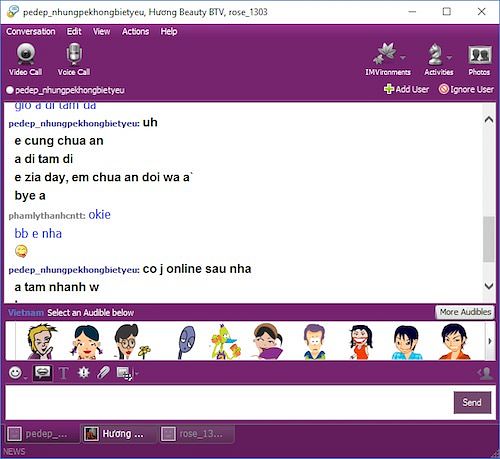My first memory of the internet in Vietnam occurred in an internet café on Tran Hung Dao Street. It was the early 2000s: Walkman players were still a thing, MTV actually played music, and Britney Spears’ bubblegum chart-toppers were the “it” tunes in local hip hangouts (mind you, Britney didn’t reach Vietnam until five years after her debut in America).
I was accompanying my sister for the first time to her weekly email extravaganza. At the time, these trips took place because she was surreptitiously corresponding with her then-boyfriend – as I later found out. However, back then the wide-eyed tweenage me really couldn’t care less about the purpose. Those internet café visits were the fancy highlight of my week, as the shop featured air-conditioning and cold beverages at your demand, and I had my own allotment of time on the net sans-parental supervision. In other words, it was like heaven.
I probably wouldn't be able to pinpoint the shop on a map today, as most internet cafés in Vietnam have shuttered over the last decade thanks to the prevalence of smartphones and WiFi. However, the only detail of those visits that still echoes in me at times even today is the dial-up internet tone – an eerie mix of digital hissing, a witch’s malicious guffaw and the sound of an electronic device committing suicide.
Vietnam’s internet landscape in the early 2000s was driven by users like my sister who formed a tentative connection to the outside world via rudimentary email accounts such as Yahoo! Mail and Microsoft’s Hotmail. YouTube was non-existent and the concept of a ubiquitous social media platform like Facebook seemed like a futuristic dream.
The early days
Vietnam was a late adopter when it came to internet access, but not by many years. Internet services officially became available in the country in December 1997. Thailand’s connection only began in 1996, while in 1995, only 0.04% of the world’s population had a dial-up connection. Half of that figure was located in the US.
What started as a tool exclusively reserved for scientific study has since gone on to become Vietnam’s most time-consuming hobby. Hanoi-based NetNam Co. is widely attributed with bringing the internet to the country. The firm was founded in 1994 and was among the first four Vietnamese internet service providers (ISPs) established in the 1990s.
At the time, the company included scientists from the Institute of Information Technology under the Vietnam Institute of Science and Technology – now the Vietnam Academy of Science and Technology.
“We initially considered the Internet an instrument for scientific study only,” Tran Ba Thai, a former NetNam director, told Tuoi Tre.

Tran Ba Thai with Professor Rob Hurle from the Australian National University. Photo via Tuoi Tre.
Thai’s company registered the national domain .vn in 1994 and started providing email addresses using it that year. However, this system wasn’t widely accessible.
Then-Prime Minister Vo Van Kiet was Vietnam’s first leader to have an email address. He also wrote to Swedish Prime Minister Nils Daniel Carl Bildt prior to the latter’s visit to Vietnam. They were the second pair of world leaders to ever correspond via email, after former US President Bill Clinton and Bildt.
The birth year of Vietnam’s internet
If Thai and his team were crucial in establishing a technological foundation to make Vietnam's internet happen, Dr. Mai Liem Truc from the Vietnam Posts and Telecommunications (VNPT) Group bore the Herculean task of convincing the conservative government to legalize the new technology.
Truc and some of his associates were already aware of internet technology and had to “resort to all lines of reasoning to persuade each other and their superiors to reach a consensus.”
In April 1997, the central government promulgated a decree granting VNPT temporary management of the internet. The policy stated that such a network was allowed, but only if “services are launched to the extent that they are controllable.”
However, Truc also pushed to deliver a presentation in front of the Politburo Standing Committee of the party. Vietnam had recently joined – and started reaping the benefits of – ASEAN in 1995, and Truc decided to use that as leverage to strengthen his position.

Dr. Mai Liem Truc. Photo via Tuoi Tre.
“The Internet is instrumental to international trade and will help lure foreign investment in the current era of international integration,” he recalled telling party officials at the time. “What we could envisage was that the connection would open to the door to economic growth, facilitate scientific research, and broaden people’s knowledge.”
Truc's team eventually received approval from the committee, followed by a green light from Prime Minister Phan Van Khai after the leader saw a presentation by the group.
The rest was history: Vietnam became part of the global internet network on November 19, 1997 – exactly 20 years ago today. The government simultaneously formed the National Internet Steering Board to oversee usage of the new technology.
20 years of change
Three years after the government started allowing Vietnamese to access the internet, the country’s usage rate was dismal: in 2000, only 0.2% of locals had the internet. Nonetheless, this situation has changed drastically over the years.
Today, some 50 million Vietnamese – mostly young people – have a stable internet connection. This amounts to 53% of the Southeast Asian country’s population. In comparison, the world average is just 47%, according to a United Nations report. Tuoi Tre also reported that 78% of those with access to the internet in Vietnam use it on a daily basis.
On the technical front, the rapid development of Vietnam’s internet access is largely thanks to the presence of undersea fiber optic cables, most prominently the Asia-America Gateway (AAG), which officially started operating in November 2009.

The AAG's connecting points. Image via Lowyat.
Prior to that, the country was dependent on a number of land-based and underwater connections, including submarine cables such as the Southeast Asia-Middle East-Western Europe 3 (SMW3) cable and the Thailand-Vietnam-Hong Kong (TVH) cable. The two connections had very limited capacities, however.
The AAG is a massive communication cable network spanning 20,000 kilometers, connecting Southeast Asia with the US via Guam and Hawaii.
In 2009 and 2016, Vietnam also connected to the global network via the Intra-Asia (IA) and Asia-Pacific Gateway (APG) cables, respectively.
The AAG, nevertheless, still serves 60% of the country’s international connections, despite its numerous breakages. In 2017 alone, it has encountered issues five times, causing nationwide internet disruptions.
The heyday of Yahoo!
It would be pointless to discuss Vietnam’s internet usage without touching on the tech giants that have gone in and out of our lives, starting with Yahoo!.
If today’s Yahoo! is only a ghost of its past self, and pretty much only exists in Japan, it was a fixture of Vietnam’s cybersphere during the national network’s infant stage. My sister’s first-ever email address – which she used to fraternize with the aforementioned boyfriend – was a Yahoo! account. So was mine.
Launched in 1998 as Yahoo! Pager, Yahoo! Messenger was where all the cool kids congregated during the chat app’s heyday. It also gave rise to Vietnam’s first instances of internet language, which included indecipherable crypto-codes such as “Ngoi` pun` hok bjk lem` je^`, vo^ tinh` nghj~ den' anh, hok bjk jo` nay` anh dang lam` j` ta?”

A typical chat window in Yahoo Messenger. Photo via Viet Bao.
Before WordPress and BlogSpot, there was Yahoo! 360, Vietnam’s own rendition of MySpace, complete with angst-ridden posts and laboriously decorated layouts. It was where people expressed wistful thoughts on the passing of seasons, disseminated delicious gossip and even fell in love, in some extreme cases.
Yahoo! launched 360 in 2005 as a blog-focused social networking website to compete with Microsoft’s MSN Spaces. The blog platform did well in Asia-Pacific and best in Vietnam, as it operated virtually competition-free in the latter. However, it tanked pretty much everywhere else, forcing Yahoo! to stop supporting the service in 2007 and eventually close it down altogether in 2009.
Recognizing Vietnam’s fondness of the dying blog platform, the company attempted to launch Yahoo! 360Plus and Yahoo! Music Vietnam in April 2008 – two services catered especially for the local market. Yahoo! also released its promotional video commercial, a now-iconic skit based on the folk tale “Tam Cam,” starring Ngo Thanh Van and Thanh Loc. At the time, the platform still had some 15 million regular users in Vietnam.
However, by then, it was too late: Facebook was here to fill the void that the death of Yahoo! 360 left in netizens' broken hearts.
The iconic "Tam Cam" promotional video for Yahoo! Messenger. Video via YouTube user Thành Lục Đức.
The reign of Facebook
From late 2008 until mid-2009, Vietnamese netizens started to hear more about this "flashy new website" called Facebook. Early adopters touted it as the latest way to globalize because “everybody overseas was on it.” Late joiners were intrigued by the new bells and whistles: there were interest groups, quizzes, games and even Note – a blog-like function, just like Yahoo! 360.
Facebook spread exponentially in Vietnam throughout 2009 and 2010, so much so that officials became wary of its reach. Services on the social media network were intermittently shaky in the country from 2009 all the way until 2012. No one knows for sure if the government was actually behind the disruptions – there was never an official announcement; however, the restrictions were rather weak, thus allowing tech-savvy users to devise ways to circumvent them.

Vietnam's social media platform usage breakdown. Graph via Vinalink.
Nowadays, Facebook’s penetration rate in Vietnam is envied by tech companies all over the world: 64 million Vietnamese have a Facebook account – 3% of the company’s global user base of 2 billion, and the country is currently ranked 7th worldwide in terms of Facebook users. Saigon is also among the top 10 cities globally, with 14 million users.
The social media platform has become so intimately intertwined with local life that it seems like everyone and their mom are on it - literally (hey mom!). Entrepreneurial netizens have set up shops on the network to sell everything from dried fish from Nha Trang to premium grapes imported from Japan and Calvin Klein knockoffs from Cambodia.
Older users – like my mom – pry for juicy gossip from colleagues and marvel at Tasty videos detailing how to make fried rice from leftovers. Young netizens, however, see Facebook as the prime stage to flex their meme-making muscles. On a daily basis slews of meme pages churn out dozens of new creations, from light-hearted but elaborate parody videos to crude photos comparing the latest beauty pageant winner to pouting aquatic creatures.
One of the most successful Vietnamese memes in recent history was the “Pikagon,” illustrator Thang Fly’s cartoon rendition of a poorly thought-out decoration in Hai Phong.

Hai Phong's dragon-shaped topiary and its meme rendition. Photo via Tech Nuy.
In 20 years, Vietnam’s internet landscape has come a long way from Thai and Truc’s limited network back in 1997. It has given rise to a robust online community that is both innovative and entrepreneurial, with a few exceptions such as cyberbullying and gory video groups, though such problems are not unique to Vietnam.
My sister and I – like most internet users in Vietnam – have now moved on to smartphones and home WiFi networks. The shrieking dial-up tone of years past is no longer a fixture of our weekends, and neither are internet cafés. I have mixed feelings about the former, but I’m definitely missing the latter.















